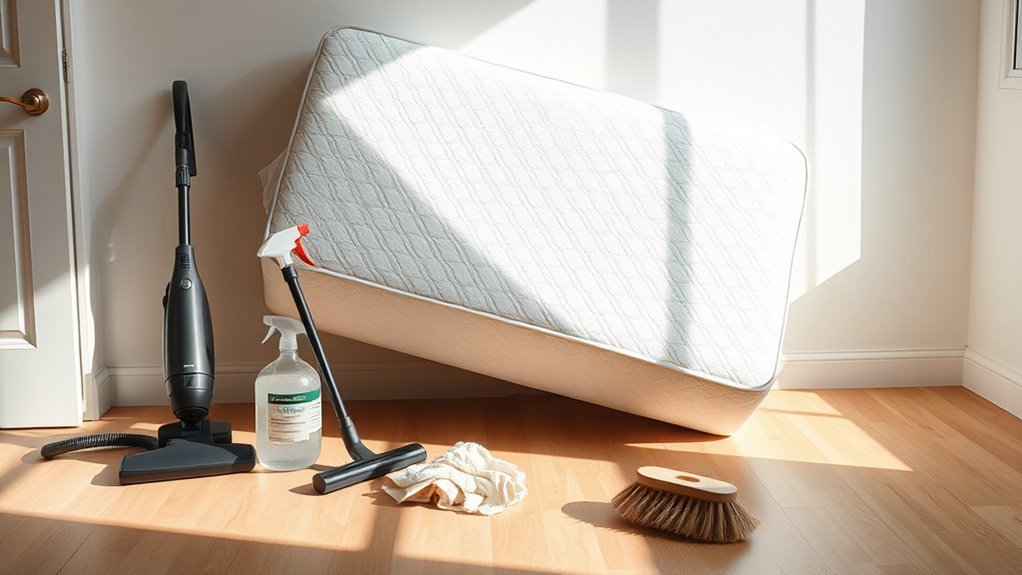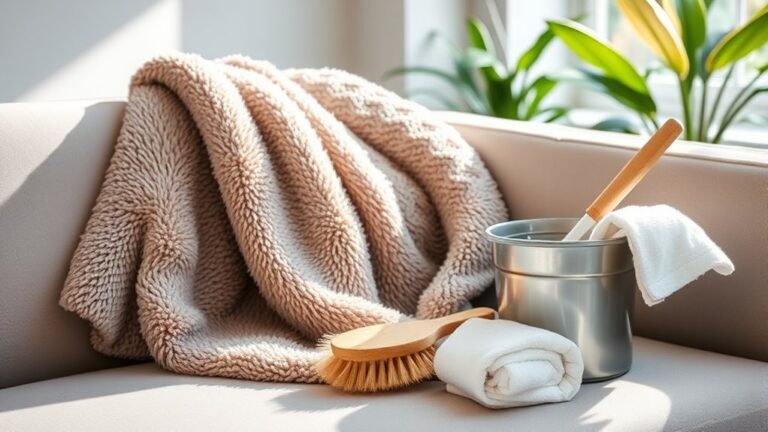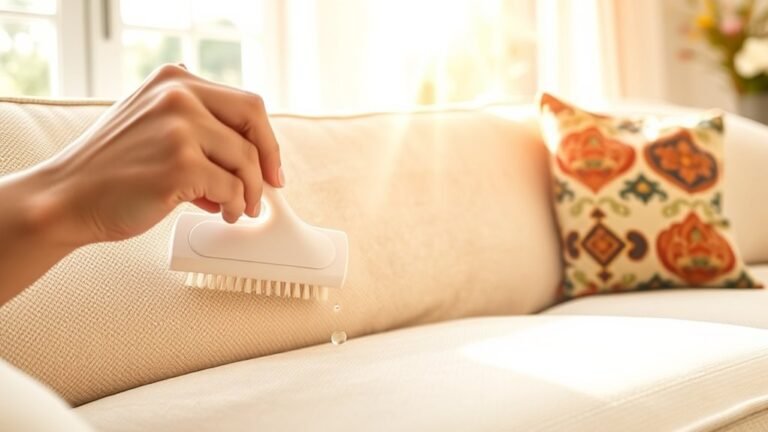Cleaning With Mattress: What Works and What Doesn’T
When cleaning your mattress, use gentle, moisture-minimal methods—vacuum regularly and spot clean with natural solutions like baking soda or diluted vinegar to avoid damage and mildew. Avoid harsh chemicals and excessive water, which can harm fabrics and cause odors. Baking soda helps neutralize smells, and protecting your mattress with a waterproof cover reduces stains and allergens. For persistent issues or older mattresses, professional cleaning may be needed. Understanding these basics helps you maintain a fresh, healthy sleep surface.
Understanding Mattress Materials and Cleaning Needs

Before you start cleaning your mattress, it’s important to understand the materials it’s made from and their specific cleaning requirements. Different mattress types—memory foam, innerspring, latex, or hybrid—respond uniquely to cleaning methods. Memory foam, for example, is sensitive to moisture and needs gentle spot cleaning, while innerspring mattresses can tolerate more thorough cleaning but require quick drying to prevent rust. Your cleaning frequency should match your mattress type and usage. Generally, vacuuming every one to three months removes dust and allergens, but spot cleaning should be done as needed. Regularly rotating your mattress can also help maintain its condition. By knowing your mattress type and adapting your cleaning frequency accordingly, you’ll protect your investment and enjoy a fresher, healthier sleep environment.
Effective Cleaning Products for Mattresses
When cleaning your mattress, choosing the right products is essential for effective stain removal and fabric care. You’ll want to opt for natural cleaning solutions whenever possible and steer clear of harsh chemicals that can damage materials or cause irritation. Understanding which stain removers work best helps you maintain a fresh and safe sleeping environment.
Best Stain Removers
Although mattresses are designed to resist stains, accidents happen, and knowing which stain removers work best can save you time and effort. For the best commercial options, look for enzyme-based cleaners—they break down organic stains like sweat or blood effectively without damaging your mattress. Oxygen-based bleach sprays are also reliable for brightening and removing tough spots. If you prefer DIY solutions, a mixture of baking soda and hydrogen peroxide can lift many stains when applied carefully and allowed to sit before blotting. Always test any product on a small, hidden area first to avoid discoloration. Avoid harsh chemicals that may harm mattress materials or void warranties. With the right stain remover, you’ll maintain your mattress’s freshness, granting you freedom from stains without hassle.
Natural Cleaning Solutions
Choosing the right stain remover is important, but you might also want to contemplate natural cleaning solutions that are gentle yet effective for your mattress. Eco friendly cleaners like baking soda and white vinegar work wonders without harsh chemicals. Baking soda absorbs odors and moisture; sprinkle it on, let it sit for a few hours, then vacuum thoroughly. For stains, mix equal parts white vinegar and water in a spray bottle, lightly mist the area, and blot with a clean cloth. These DIY solutions are not only safe but also budget-friendly, giving you control over what touches your mattress. Using natural products lets you maintain a fresh, clean sleeping environment while supporting your freedom from synthetic chemicals. Simple, effective, and eco conscious—that’s cleaning with confidence.
Avoid Harsh Chemicals
Since your mattress is a place you spend many hours each night, it’s essential to avoid harsh chemicals that can irritate your skin or respiratory system. Instead, choose eco friendly alternatives that clean effectively without harmful residues. Chemical free solutions like baking soda, white vinegar, and essential oils can eliminate odors and stains while maintaining your mattress’s integrity. These options reduce exposure to toxins and promote a healthier sleeping environment. Avoid bleach, ammonia, and synthetic detergents, which may cause allergies or damage mattress materials. By opting for natural, gentle cleaners, you preserve both your mattress and your well-being. Embracing these safe methods grants you the freedom to maintain a fresh mattress without compromising your health or the environment.
Home Remedies That Actually Work
When you’re looking to freshen up your mattress without harsh chemicals, several home remedies can be surprisingly effective. Here’s a methodical approach you can try:
- Baking soda: Sprinkle it evenly to neutralize odors. Let it sit for several hours, then vacuum thoroughly.
- Vinegar solution: Mix equal parts white vinegar and water in a spray bottle. Lightly mist stains and blot with a clean cloth.
- Sunlight: If possible, place your mattress in direct sunlight for a few hours. UV rays naturally kill bacteria and mites.
- Essential oils: Add a few drops to baking soda before sprinkling for a fresh scent without synthetic fragrances.
These remedies offer a safe, effective way to maintain your mattress’s freshness and hygiene—without sacrificing your freedom from chemicals.
Common Cleaning Mistakes to Avoid

While home remedies can be effective for mattress cleaning, it’s easy to make mistakes that reduce their benefits or even cause damage. One common misconception is over-cleaning; too frequent cleaning can wear out mattress materials. Another mistake is using excessive water, which leads to mold growth. Avoid harsh chemicals that can degrade fabrics or irritate skin.
| Mistake | Why to Avoid It |
|---|---|
| Over-cleaning | Shortens mattress lifespan |
| Excessive water use | Promotes mold and mildew |
| Ignoring cleaning frequency | Leads to buildup and odors |
| Using harsh chemicals | Damages fabric and affects health |
Understanding these pitfalls helps you maintain your mattress effectively while preserving your freedom to rest easy.
How to Remove Stubborn Stains Safely
To remove stubborn stains safely, you first need to identify the type of stain you’re dealing with. Choosing the right cleaning solution is essential to avoid damaging your mattress. Next, use targeted stain removal techniques that are effective yet gentle on the fabric.
Identifying Stain Types
How can you effectively tackle stubborn stains on your mattress without causing damage? First, you need to identify the stain type since each requires a different approach. Here’s how to recognize common stains:
- Blood stains often appear dark red or brown, typically from cuts or nosebleeds.
- Urine and sweat stains leave yellowish marks, usually accompanied by a distinctive odor.
- Food and oil stains are greasy or sticky, sometimes accompanied by discoloration or residue.
- Ink stains show as sharp, dark spots, while mold and mildew stains look fuzzy or patchy with a musty smell.
Knowing the stain type helps you choose the right cleaning method that preserves your mattress’s integrity and keeps it fresh.
Safe Cleaning Solutions
Since stubborn stains vary in nature, choosing safe cleaning solutions is crucial to avoid damaging your mattress. You’ll want to avoid harsh chemicals that can break down mattress fibers or leave harmful residues. Instead, opt for chemical free alternatives like baking soda, white vinegar, or mild castile soap. These eco friendly products are gentle yet effective, preserving your mattress’s integrity while tackling stains safely. Always test your chosen solution on a small, hidden area first to verify it won’t discolor or weaken the fabric. Use minimal liquid to prevent moisture buildup, which can lead to mold. By selecting safe, eco friendly options, you maintain a clean mattress without sacrificing health or freedom from toxic cleaners. This careful approach sets the stage for effective stain removal techniques.
Stain Removal Techniques
Three key steps will help you remove stubborn stains from your mattress safely and effectively. First, act quickly to prevent stains from setting in. Second, maintain a regular cleaning frequency to keep your mattress fresh and minimize buildup. Third, use gentle, tested methods for stain removal.
Follow these steps:
- Blot the stain immediately with a clean cloth—don’t rub, or you’ll spread it.
- Apply a mild cleaning solution like diluted white vinegar or baking soda paste.
- Let it sit for 10-15 minutes, then blot again to lift the stain.
- Allow the mattress to air dry completely to avoid mold growth.
Dealing With Odors: What Really Helps
Why do some odors linger on your mattress despite regular cleaning? It’s often because surface cleaning doesn’t address deep-seated smells. To effectively tackle odors, focus on odor absorption methods like sprinkling baking soda evenly over the mattress. Let it sit for several hours to absorb moisture and smells, then vacuum thoroughly. For scent enhancement, avoid overpowering sprays that mask odors temporarily. Instead, try adding a few drops of essential oils to the baking soda before application. This method neutralizes odors while leaving a subtle, natural fragrance. Remember, thorough drying after cleaning is vital to prevent mold-related smells. By combining odor absorption with thoughtful scent enhancement, you’ll regain a fresh mattress without relying on harsh chemicals or ineffective quick fixes.
Preventing Allergens and Dust Mites

Although regular cleaning helps, preventing allergens and dust mites in your mattress requires specific strategies. For effective allergen reduction and dust mite prevention, focus on these steps:
- Air out your mattress regularly to reduce moisture, which attracts dust mites.
- Maintain low humidity in your bedroom; dust mites thrive in humid environments.
- Wash bedding weekly in hot water (at least 130°F) to kill dust mites and remove allergens.
- Vacuum your mattress frequently using a vacuum with a HEPA filter to trap allergens effectively.
The Role of Mattress Protectors in Maintenance
Since your mattress faces daily exposure to sweat, spills, and dust, using a mattress protector is essential for maintaining its cleanliness and longevity. Mattress protector benefits include preventing stains, reducing allergen buildup, and extending mattress life. When choosing mattress protectors, consider waterproofing, material breathability, and ease of cleaning to match your lifestyle.
| Feature | Benefit | What to Look For |
|---|---|---|
| Waterproof Layer | Guards against spills | TPU or vinyl backing |
| Breathable Fabric | Maintains comfort | Cotton or bamboo blends |
| Easy Care | Simplifies maintenance | Machine washable designs |
When to Consider Professional Mattress Cleaning
If you notice persistent stains, odors, or allergy symptoms despite regular cleaning, it might be time to contemplate professional mattress cleaning. Your mattress lifespan and cleaning frequency play crucial roles in deciding when to call the experts. Consider professional cleaning if:
- You’ve kept up with regular cleaning, but odors or stains remain.
- Allergy symptoms worsen, hinting at deep-seated dust mites or mold.
- Your mattress is nearing the end of its typical lifespan (around 7-10 years) and needs a thorough refresh.
- You’ve experienced spills or accidents that home methods can’t fully resolve.
Professional services go beyond surface cleaning, extending your mattress’s usability and ensuring a healthier sleep environment. Don’t wait until problems escalate—act based on your mattress’s condition and cleaning history.
Frequently Asked Questions
Can Mattress Cleaning Improve My Sleep Quality?
Improving your sleep quality often starts with good sleep hygiene, and a clean mattress plays a big role. Using effective cleaning methods like vacuuming, spot cleaning, and using mattress protectors helps reduce dust mites and allergens that disrupt sleep. When your mattress is fresh and hygienic, it creates a more comfortable environment, letting you rest better and wake up refreshed. So yes, proper mattress cleaning can definitely boost your sleep quality.
How Often Should I Rotate My Mattress?
It’s a coincidence that rotating your mattress regularly not only boosts your freedom from discomfort but also extends mattress longevity. You should rotate your mattress every three to six months for maximum rotation—flipping or switching head to foot. This method guarantees even wear, preventing sagging and prolonging comfort. By sticking to this schedule, you maintain the support you need for restful sleep, giving you more freedom to enjoy your days.
Is Vacuuming Alone Enough for Mattress Hygiene?
Vacuuming alone isn’t enough for thorough mattress hygiene. While vacuuming techniques help remove dust, dirt, and allergens from the surface, mattress maintenance also requires spot cleaning stains, airing out the mattress, and using mattress protectors. You’ll want to vacuum regularly using a vacuum with a HEPA filter and upholstery attachment to maximize dust removal. Combine these steps for a cleaner, fresher mattress that supports your freedom to sleep well.
Can Mattress Cleaning Prevent Bed Bugs?
Think of mattress cleaning as your shield in a fantasy tale—vital but not invincible. While good mattress hygiene, like regular vacuuming and using protective covers, helps reduce bed bug prevention risks, it can’t guarantee total freedom from infestations. Bed bugs often hide in cracks beyond your mattress. So, combine cleaning with vigilant inspection and professional treatment if needed, ensuring your sleep sanctuary stays bug-free and comfortable.
Are Mattress Cleaning Sprays Safe for Pets?
You should be cautious about mattress cleaning sprays around pets. Not all products are created equal, so look for pet-friendly options labeled specifically for chemical safety. These sprays avoid harsh ingredients that could harm your furry friends. Always read labels carefully and test in a small area first. If you want to keep your space fresh without risking your pet’s health, choosing chemical-safe, pet-approved sprays is the safest route.






